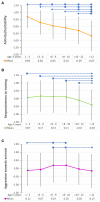Cross-Sectional Age Differences in Canine Personality Traits; Influence of Breed, Sex, Previous Trauma, and Dog Obedience Tasks
- PMID: 31993445
- PMCID: PMC6971055
- DOI: 10.3389/fvets.2019.00493
Cross-Sectional Age Differences in Canine Personality Traits; Influence of Breed, Sex, Previous Trauma, and Dog Obedience Tasks
Abstract
The dog has been suggested as a possible model for personality development over the lifespan, however, we know little about how aging may shape their personality or the magnitude of age-related changes. Previously we established that aging influences multiple dog demographics, which could also affect how personality traits change across different age periods. A demographic questionnaire and the Dog Personality Questionnaire were completed for a cross-sectional sample of 1,207 adult dogs living in Hungary (Mage = 7.71, SD = 4.12), split into six different age groups. Results revealed three of the five factors showed significant age effects. Activity/Excitability decreased with age, and whilst Responsiveness to training also decreased, only dogs older than 12 years differed significantly from the other groups. Aggressiveness toward animals showed a quadratic trajectory peaking in dogs aged 6-10 years. The greatest magnitude of age-related change was detected between late senior and geriatric ages, likely caused by compensatory behavioral changes to biological aging and owner attitudes to aging. When the models were re-run including the other explanatory variables, age group was no longer significant for the Responsiveness to training trait. The amount of time spent interacting/playing with the owner partially mediated the relationship between age and this trait, implying that interventions to increase play and training motivation may alleviate the negative effects of aging on dogs' trainability. Fifteen out of 28 explanatory variables were significantly associated with at least one of the five factors [weight, breed (pure/mixed breed), sex, off-leash activity, diet, previous trauma, age of dog when arrived in the household, play, dog training activities, number of known commands and dog obedience tasks]. Similarly to humans, dogs that had previously experienced trauma scored higher in fearfulness and aggression. A higher level of basic obedience was linked to some desirable dog personality traits (lower Fearfulness and Aggression, and higher Activity/Excitability and Responsiveness to training). Regardless of the direction of this relationship, obedience is an important aspect contributing to dog personality questionnaires and the dog-owner relationship. This study is unique in that it considered a wide variety of demographic variables which are influenced by aging.
Keywords: aging; cross-sectional; demographics; development; dog personality; dog-human bond; trauma.
Copyright © 2020 Wallis, Szabó and Kubinyi.
Figures


Similar articles
-
Dog and owner demographic characteristics and dog personality trait associations.Behav Processes. 2009 Jul;81(3):392-401. doi: 10.1016/j.beproc.2009.04.004. Behav Processes. 2009. PMID: 19520239
-
Demographic Change Across the Lifespan of Pet Dogs and Their Impact on Health Status.Front Vet Sci. 2018 Aug 23;5:200. doi: 10.3389/fvets.2018.00200. eCollection 2018. Front Vet Sci. 2018. PMID: 30191153 Free PMC article.
-
Seizure-alerting behavior in dogs owned by people experiencing seizures.Epilepsy Behav. 2019 May;94:104-111. doi: 10.1016/j.yebeh.2019.02.001. Epub 2019 Mar 18. Epilepsy Behav. 2019. PMID: 30897533
-
Persistence and resistance to extinction in the domestic dog: Basic research and applications to canine training.Behav Processes. 2017 Aug;141(Pt 1):67-74. doi: 10.1016/j.beproc.2017.04.001. Epub 2017 Apr 6. Behav Processes. 2017. PMID: 28392243 Review.
-
Current perspectives on attachment and bonding in the dog-human dyad.Psychol Res Behav Manag. 2015 Feb 24;8:71-9. doi: 10.2147/PRBM.S74972. eCollection 2015. Psychol Res Behav Manag. 2015. PMID: 25750549 Free PMC article. Review.
Cited by
-
Shorter headed dogs, visually cooperative breeds, younger and playful dogs form eye contact faster with an unfamiliar human.Sci Rep. 2021 Apr 29;11(1):9293. doi: 10.1038/s41598-021-88702-w. Sci Rep. 2021. PMID: 33927315 Free PMC article.
-
Reliability and Validity of a Dog Personality and Unwanted Behavior Survey.Animals (Basel). 2021 Apr 24;11(5):1234. doi: 10.3390/ani11051234. Animals (Basel). 2021. PMID: 33923262 Free PMC article.
-
Behavioural and cognitive changes in aged pet dogs: No effects of an enriched diet and lifelong training.PLoS One. 2020 Sep 16;15(9):e0238517. doi: 10.1371/journal.pone.0238517. eCollection 2020. PLoS One. 2020. PMID: 32936808 Free PMC article.
-
Differential behavioral aging trajectories according to body size, expected lifespan, and head shape in dogs.Geroscience. 2024 Apr;46(2):1731-1754. doi: 10.1007/s11357-023-00945-9. Epub 2023 Sep 23. Geroscience. 2024. PMID: 37740140 Free PMC article.
-
Potential interactive effect of positive expectancy violation and sleep on memory consolidation in dogs.Sci Rep. 2024 Apr 25;14(1):9487. doi: 10.1038/s41598-024-60166-8. Sci Rep. 2024. PMID: 38664506 Free PMC article.
References
LinkOut - more resources
Full Text Sources

